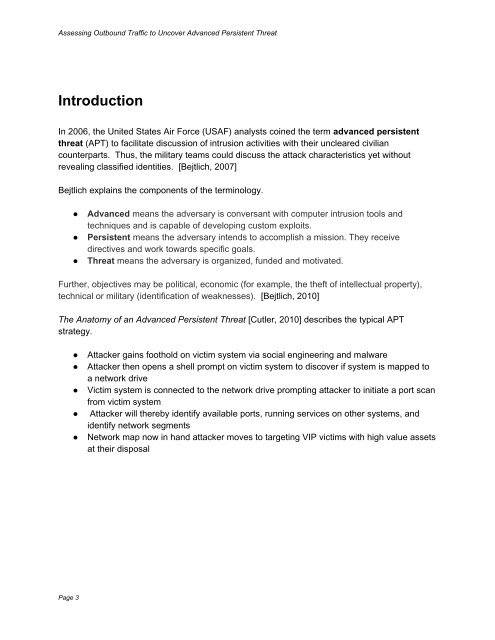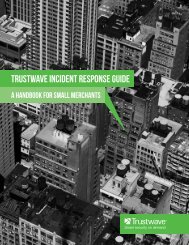JWP-Binde-McRee-OConnor
JWP-Binde-McRee-OConnor
JWP-Binde-McRee-OConnor
You also want an ePaper? Increase the reach of your titles
YUMPU automatically turns print PDFs into web optimized ePapers that Google loves.
Assessing Outbound Traffic to Uncover Advanced Persistent Threat<br />
Introduction<br />
In 2006, the United States Air Force (USAF) analysts coined the term advanced persistent<br />
threat (APT) to facilitate discussion of intrusion activities with their uncleared civilian<br />
counterparts. Thus, the military teams could discuss the attack characteristics yet without<br />
revealing classified identities. [Bejtlich, 2007]<br />
Bejtlich explains the components of the terminology.<br />
●<br />
●<br />
●<br />
Advanced means the adversary is conversant with computer intrusion tools and<br />
techniques and is capable of developing custom exploits.<br />
Persistent means the adversary intends to accomplish a mission. They receive<br />
directives and work towards specific goals.<br />
Threat means the adversary is organized, funded and motivated.<br />
Further, objectives may be political, economic (for example, the theft of intellectual property),<br />
technical or military (identification of weaknesses). [Bejtlich, 2010]<br />
The Anatomy of an Advanced Persistent Threat [Cutler, 2010] describes the typical APT<br />
strategy.<br />
●<br />
●<br />
●<br />
●<br />
●<br />
Attacker gains foothold on victim system via social engineering and malware<br />
Attacker then opens a shell prompt on victim system to discover if system is mapped to<br />
a network drive<br />
Victim system is connected to the network drive prompting attacker to initiate a port scan<br />
from victim system<br />
Attacker will thereby identify available ports, running services on other systems, and<br />
identify network segments<br />
Network map now in hand attacker moves to targeting VIP victims with high value assets<br />
at their disposal<br />
Page 3










